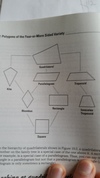Geometry Flashcards
(120 cards)
Dimensions of a point
0
Dimensions of a line
1
Dimensions of a plane
2
Types of 1 dimensional shapes
line, ray, segment
Collinear
points on the same line (any 2 points are collinear)
Coplanar
points or lines on the same plane. Any 3 points are coplanar
2 possibilities of coplanar lines
either parallel or intersecting (coplanar rays and segments do not have to be one of the two)
Perpendicular lines, segments, or rays
intersect at 90
Oblique lines, segments, or rays
intersect at any angle except for 90
Skew lines, segments, or rays
noncoplanar
2 possibilities of 2 planes
parallel or intersecting
acute angle
less than 90
right angle
90
obtuse angle
greater than 90
Straight angle
180
Reflex angle
More than 180 (the other side of an ordinary angle)
Adjacent angles
Neighboring angles that have the same vertex and share a side, and neither angle can be inside the other
Complementary angle
two angles that add up to 90
Supplementary angle
two angles that add up to 180
Vertical angles
at an intersection of two lines, the two angles opposite of each other
Congruent segments
2 segments that are the same length
Segment with out the line above it
referring to the distance, so use = sign instead of congruent sign
Congruent angles
angles that are equal
Bisect / trisect
2 / 3 equal parts of the original (divide doesn’t have to be equal)




















